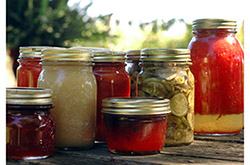
If you have room in the freezer, freezing produce is a quick solution to beat the conundrums that can come up during a great growing season. Freezing works when:
- You have a little too much to can (but not another full canner load).
- You do not have enough for even one canner load.
- You have produce that needs to be preserved and you don’t have time to can or dehydrate it.
- Your canned jars don’t seal (and it’s still within 24 hours since processing).
- You would like to save some for use later (e.g., you have a few tomatoes now and then a few more later – not enough for a full batch of spaghetti sauce all harvested at once).
Compared to canning or dehydrating, freezing can be very easy.
For vegetables, blanch before freezing to destroy enzymes and prevent loss of quality, flavor, texture and color. Each type of vegetable has its appropriate time. Check the MU Extension publication Quality for Keeps: Freezing Vegetables (GH1503) for specifics.
Fruits can also be frozen fairly easily. Instead of blanching, use ascorbic acid to prevent darkening during preparation and freezing. Mix 1 teaspoon (3,000 milligrams) ascorbic acid to one gallon of cool water and cover light-colored fruit during peeling and slicing. Fruit can be packed in a syrup, sugar, unsweetened or fruit juice pack or can be frozen as crushed fruit or fruit puree. For each method, MU Extension publication Quality for Keeps: Freezing Fruits (GH1502) gives directions on how to mix in the ascorbic acid.
Both fruits and vegetables can be packaged with a tray pack to keep pieces separate after storing. When preparing fruit for freezing, do not use galvanized, copper or iron equipment. The acid in the fruit could react with the metals forming harmful compounds or off flavors.
Unlike canning, with its very specific guidelines for amounts and containers, freezing allows more flexibility. Frozen produce can be stored in any convenient quantity, depending on its end use. Packaging can be plastic freezer bags or boxes, glass (if specifically designated for freezing), or any container that insures a moisture and vapor barrier.
Go to MU Extension's Food Preservation program for more home food preservation tips.